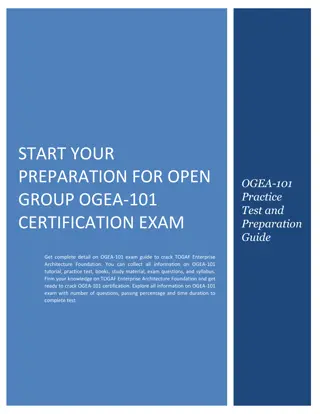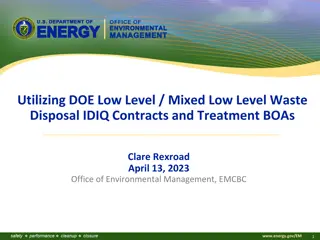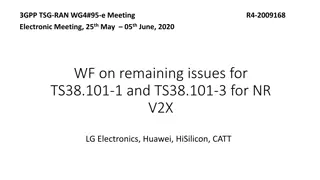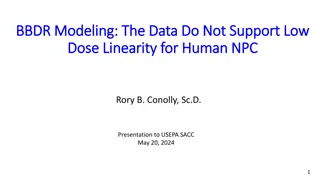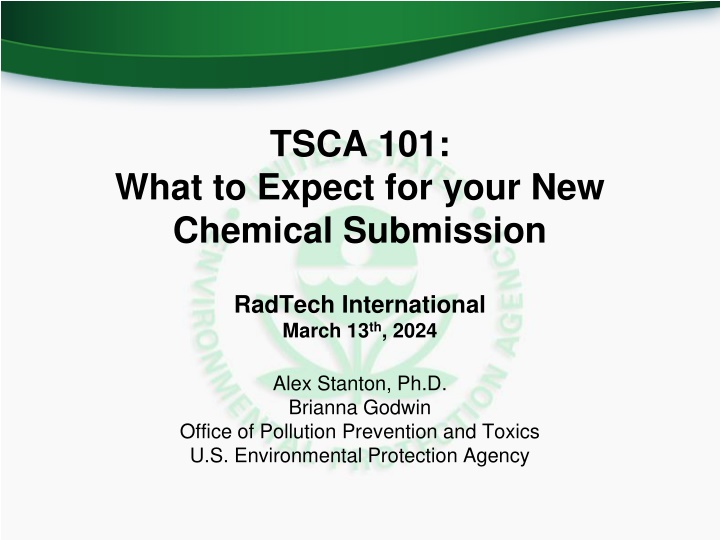
TSCA and New Chemical Regulations
Learn about the Toxic Substances Control Act (TSCA) and the regulations surrounding new chemical submissions, including PMN and SNUN notifications, determinations for new chemicals, and key requirements under the Frank R. Lautenberg Chemical Safety Act.
Download Presentation

Please find below an Image/Link to download the presentation.
The content on the website is provided AS IS for your information and personal use only. It may not be sold, licensed, or shared on other websites without obtaining consent from the author. If you encounter any issues during the download, it is possible that the publisher has removed the file from their server.
You are allowed to download the files provided on this website for personal or commercial use, subject to the condition that they are used lawfully. All files are the property of their respective owners.
The content on the website is provided AS IS for your information and personal use only. It may not be sold, licensed, or shared on other websites without obtaining consent from the author.
E N D
Presentation Transcript
TSCA 101: What to Expect for your New Chemical Submission RadTech International March 13th, 2024 Alex Stanton, Ph.D. Brianna Godwin Office of Pollution Prevention and Toxics U.S. Environmental Protection Agency
TSCA and Chemical Safety The Frank R. Lautenberg Chemical Safety for the 21st Century Act Amends and updates the Toxic Substances Control Act (TSCA) Signed by the President on June 22, 2016 Effective immediately Significance First major update to TSCA in 40 years (1976) The amended TSCA requires EPA to make an affirmative finding on new chemicals or significant new uses of existing chemicals, before those chemicals can enter the market or manufacturing/processing for new uses can commence 2
PMN (Premanufacture) and SNUN (Significant New Use) Notifications Mandated by Section 5 of the Toxic Substances Control Act (TSCA), EPA's New Chemicals program helps manage the potential risk to human health and the environment from chemicals new to the marketplace Section 5 of TSCA requires anyone who plans to manufacture (including import) a new chemical substance for a non-exempt commercial purpose or for a significant new use (designated by EPA) to provide EPA with notice before initiating the activity EPA must review a chemical under the conditions of use and make one of five affirmative findings in TSCA section 5(a)(3) before manufacturing/processing activity can commence. 3
Types of Determinations for New Chemicals Presents an Unreasonable Risk - Section 5(f) order: Restriction/ prohibition of manufacturing, processing, or distribution - Section 6(a) Proposed Rule: Restriction/ prohibition of manufacturing, processing, distribution, or disposal Produced in substantial quantities and may reasonably be anticipated to enter the environment in substantial quantities or there may be significant or substantial human exposure -Section 5(e) order Not Likely to present an unreasonable risk - Commercializati on can commence after the determination is made - Section 5(g) Statement in the FR Insufficient information to permit a reasoned evaluation and may present unreasonable risk - Section 5(e) regulation pending more information - Section 5(e) order Information is insufficient to permit a reasoned evaluation of the risk - Section 5(e) regulation pending more information - Section 5(e) order 4
Exemptions from PMNs & SNUNs Exemption Application Not Required for: R&D Chemicals Exempted Polymers of Low Concern (only annual reporting) Submission of Exemption Application Required: Low Volume ( 10,000 Kg/Yr) - 30 Day Review Low Release/Exposure (LOREX) - 30 Day Review Test Market Exemption (TME) - 45 Day Review TSCA Experimental Release Application 60 Day Review Tier I and Tier 2 Biotechnology Exemptions 5
Regulatory Outcomes for Exemptions For all exemption applications, EPA assesses whether the manufacture, processing, distribution in commerce, use, or disposal of the substance will present an unreasonable risk to human health or the environment. Grant An exemption is granted if the chemical substance meets the eligibility requirements for the exemption. Specific conditions/controls detailed in the application must be maintained throughout the duration of the exemption. Deny The chemical substance does not meet the eligibility requirements for the exemption. 6
Conditions of Use Conditions of use: the circumstances as determined by the Administrator, under which a chemical substance is intended, known, or reasonably foreseen to be manufactured, processed, distributed in commerce, used or disposed of. Intended conditions of use Circumstances as stated in the section 5 submission, including risk mitigating practices and controls Known conditions of use Circumstances where chemical substance is already manufactured pursuant to a TSCA section 5(h)(4) exemption (and therefore is not on the TSCA Inventory) Reasonably foreseen conditions of use Future circumstances that EPA might expect to occur; fact specific; based on Agency s professional judgment, experience, and discretion 7
Section 5 Review and Determination Determination: Presents an unreasonable risk the relevant chemical substance or significant new use presents an unreasonable risk of injury to health or the environment, without consideration of costs or other nonrisk factors, including an unreasonable risk to a potentially exposed or susceptible subpopulation identified as relevant by the Administrator under the conditions of use. TSCA 5(a)(3)(A) Outcome: the Administrator shall take the actions required under section 5(f) Regulation under section 5(f) Protection Against Unreasonable Risks Section 5(f) order or section 6(a) proposed rule Restriction or prohibition of chemical substance Significant new use rule (SNUR) issued following order 8
Section 5 Review and Determination Determination: May present an unreasonable risk In the absence of sufficient information to permit the Administrator to make a reasoned evaluation of the health and environmental effects of the chemical substance, the manufacture, processing, distribution in commerce, use, or disposal of such substance, or any combination of such activities, may present an unreasonable risk of injury to health or the environment, without consideration of costs or other nonrisk factors, including an unreasonable risk to a potentially exposed or susceptible subpopulation identified as relevant by the Administrator. TSCA 5(a)(3)(B)(i)(I). Outcome: the Administrator shall take the actions required under section 5(e) Regulation under section 5(e) Regulation Pending the Development of Information Section 5(e) order - Typically a consent order Commercialization with restrictions Testing, if required, is generally due at a specified point after commercialization of the chemical substance, unless risks cannot be mitigated then testing needed before commercialization of the chemical substance Significant new use rule (SNUR) issued following order 9
Section 5 Review and Determination Determination: Chemical substances produced in substantial quantities (i.e., the exposure-based finding) Such substance is or will be produced in substantial quantities, and such substance either enters or may reasonably be anticipated to enter the environment in substantial quantities or there is or may be significant or substantial human exposure to the substance. TSCA 5(a)(3)(B)(ii)(II). Outcome: the Administrator shall take the actions required under section 5(e) Regulation under section 5(e) Regulation Pending the Development of Information Section 5(e) order - Typically a consent order Commercialization without restrictions Testing generally due at a specified point after commercialization of the chemical substance Significant new use rule (SNUR) issued following order 10
Section 5 Review and Determination Determination: Insufficient information available to permit a reasoned evaluation o The information available to the Administrator is insufficient to permit a reasoned evaluation of the health and environmental effects of the relevant chemical substance or significant new use. TSCA 5(a)(3)(B)(i). Outcome: the Administrator shall take the actions required under section 5(e) o Regulation under section 5(e) Regulation Pending the Development of Information Section 5(e) order - Typically a consent order Testing generally required before commercialization of the chemical substance can occur 11
Section 5 Review and Determination Determination: Not Likely to Present an Unreasonable Risk The relevant chemical substance or significant new use is not likely to present an unreasonable risk of injury to health or the environment, without consideration of costs or other nonrisk factors, including an unreasonable risk to a potentially exposed or susceptible subpopulationidentified as relevant by the Administrator under the conditions of use. TSCA 5(a)(3)(C). Outcome: the submitter may commence manufacture of the chemical substance or manufacture or processing for a significant new use Section 5(g) Statement on Administrator Finding Commercialization of the chemical substance can commence after a not likely to present determination is made, notwithstanding any remaining portion of the review period EPA may base the not likely finding on a proposed significant new use rule (SNUR) which includes certain reasonably foreseen uses as significant new uses requiring notification to EPA before they may commence. EPA may issue a SNUR following a not likely finding to prevent certain conditions of use which, while not reasonably foreseen, could present an unreasonable risk and should be reviewed by EPA before they may commence. 12
Information Manufacturers Must Submit Chemical Identity By-products and impurities Estimated production/import volume Proposed uses and amounts for each use Human exposure information Disposal methods and estimates of releases to the environment Existing test data in notifier s possession or control (or otherwise reasonably ascertainable) concerning human and environmental effects 13
Overview of EPA Assessments Under TSCA, OPPT evaluates and regulates, as appropriate, the full life cycle of a chemical, i.e., manufacture (including import), processing, distribution in commerce, use and disposal Risk assessments for a wide variety of industrial chemicals Data availability/quality varies, but generally limited/incomplete 14
Risk Assessment Overview Chemistry Chemical and physical properties, synthesis/residuals/impurities, uses and reasonably foreseen uses Fate Persistence, bioaccumulation, removal/treatment efficiencies, sorption, migration to groundwater, degradation rate Exposure Environmental releases, models for industrial/commercial settings, occupational exposure, general population, consumers Ecotoxicity Data (measured/estimated) for aquatic organisms, ECOSAR, AIM Human Health Toxicity Evaluate hazard endpoints both qualitatively (irritation, sensitization, mutagenicity) and quantitatively (points of departure from experimental studies), AIM, OECD QSAR Toolbox, structural alerts
Chemical Category Use in Evaluation When a new substance is identified as being a member of a category, the chemical is evaluated in the context of the potential health or environmental concerns associated with that category Identification of a chemical as belonging in a New Chemical Program Chemical Category happens early and streamlines/focuses hazard assessment New Chemical Program Categories include Testing Strategies; hence, if testing is deemed necessary, there is a distinct and consistent approach Identification of tests is expedited Transparency in testing expectations 17
Chemicals for 3D Printing Three main types of chemicals involved in 3D printing: monomers, additives, photoinitiators. EPA has received over 60 new chemical notices under TSCA for substances related to 3D printing, about half of which were LVEs Chemicals reactive enough to be used in 3D printing often have chemical functionalities that are considered hazardous to human health and/or the environment Data on the NCS, literature studies on analogues, chemical category, EPA risk- screening models (available publicly: Sustainable Futures) The Agency has taken action to control and limit exposures to these chemicals, including: Limiting the uses of these materials Requiring the use of personal protective equipment and engineering controls Limiting environmental release 18
STANDARDIZATION AND GLOBAL HARMONIZATION 19
Voluntary Consensus Standards The National Technology Transfer and Advancement Act (NTTAA, Public Law 103 114) states that Federal agencies shall: Use Voluntary Consensus standards (VCS) as a means to carry out policy objectives Consult with VCS bodies Participate in the development of VCS such as test methods, specifications, and terminology whenever such participation is in the public interest and is compatible with agency missions, that are developed or adopted by VCS bodies using procedures that have safeguards to ensure that the standards development process is open to all interested parties, and that all input and viewpoints are taken into account and treated fairly For example, American Society for Testing and Materials and American National Standards Institute are two commonly known VCS bodies 20
Organisation for Economic Cooperation and Development OECD has established a Working Party on Manufactured Nanomaterials (WPMN); that is engaged in a variety of projects to further understanding of the properties and potential risks of nanomaterials and advanced materials: Testing and assessment Risk assessment and regulatory programmes Exposure assessment and mitigation Cooperation on the environmentally sustainable use of nanotechnology EPA is actively participating in the Working Party and contributes to all of the projects which help leverage international expertise and resources. These OECD projects will contribute to EPA's efforts to evaluate the potential impacts of advanced materials on human health and the environment. 21
International Standards Organization (ISO) The ISO has established a technical committee to develop international standards for additive manufacturing. This technical committee, ISO/TC 261, is working to develop standards for: process chains of AM technology data formats, structures, and metrics for AM modeling systematic development, modification and use of mold-free production processes (AM) standardized test procedures with specified quality parameters to assist users assessing different additive processes standardization of vocabulary required to define the product and to find a common speech (adapted from ISO TC 261 N 378) ISO standards are often referenced in OECD test guidelines EPA strives to use OECD test guidelines and ISO standards where appropriate in reviewing NMs as new chemicals 22
Thank you For More Information: https://www.epa.gov/assessing-and-managing- chemicals-under-tsca/frank-r-lautenberg-chemical-safety-21st-century-act Contact EPA at: https://www.epa.gov/assessing-and-managing-chemicals-under- tsca/forms/assessing-and-managing-chemicals-under-tsca Alexandria Stanton, Ph.D. 202-564-5574, Stanton.alexandria@epa.gov Brianna Godwin, 202-565-0076, godwin.Brianna@epa.gov 23


